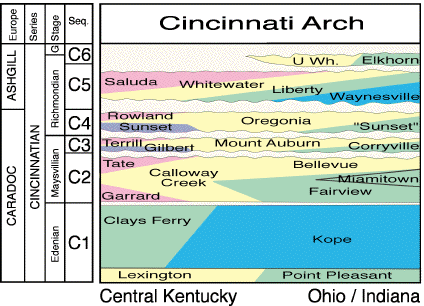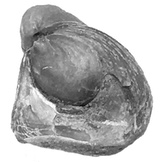Sequence Stratigraphy of the Type Cincinnatian Series: 3rd-order Sequences

The rocks of the type Cincinnatian Series are divisible into six large-scale depositional sequences, numbered C1 to C6, from oldest to youngest. Facies are color-coded, with peritidal facies in pink, shallow subtidal in yellow, deep subtidal in green, offshore in blue, and lagoonal in purple. Because each of these sequences is between 1–10 million year in duration, they are considered 3rd-order sequences. A depositional sequence (see Online Guide to Sequence Stratigraphy for more details about sequence stratigraphy) is an unconformity bounded unit. Within each of these Cincinnatian sequences is a basal transgressive systems tract, which tends to be thin, and a thicker, overlying highstand systems tract. Lowstand systems tracts are unknown in the type Cincinnatian and presumably indicate that sea level fell and totally exposed the Cincinnatian ramp at each of the sequence boundaries. By definition, facies within the transgressive systems tracts display a net deepening upward trend and those within the highstand systems tract form a net shallowing upward trend. Because most of the Cincinnatian sequences are dominated by the highstand systems tract, they are characterized predominantly by overall upward shallowing.
Facies within each sequence have conformable, gradational contacts. For this reason, it can be difficult to determine precisely where one facies ends and another begins. Because most Cincinnatian formations are based on these facies, formational contacts within the Cincinnatian are largely gradational. The presence of this cyclicity and the gradational nature of these facies contacts have led to numerous systems of nomenclature, with varying degrees of lumping and splitting of facies (see Stratigraphic Nomenclature).
Facies bordering each sequence boundary tend to have sharp, nonconformable contacts. Thin, unusual facies, such as anomalous bands of phosphatic, crinoidal, cross-bedded, and amalgamated grainstones, are commmonly found at sequence boundaries in the Cincinnatian, such as at the Oregonia-Waynesville contact. The unusual gastropodal-crinoidal grainstone of the Marble Hill Bed near Bedford, Kentucky, also lies atop a sequence boundary.
Although described in different terms, this large-scale cyclicity has been described in the type Cincinnatian Series by numerous workers, including Bob Anstey, Helen Hay, Rick Tobin, and Gordon Weir. These sequences can be recognized not only on the Cincinnati Arch, but also in New York, the Valley and Ridge province from Pennsylvania to Alabama, as well as on the Nashville Dome in Tennessee. Their wide distribution suggests that their formation was driven by eustatic changes in sea level. Geochemical and petrographic study of these sequence boundaries confirms subaerial exposure along these surfaces.

